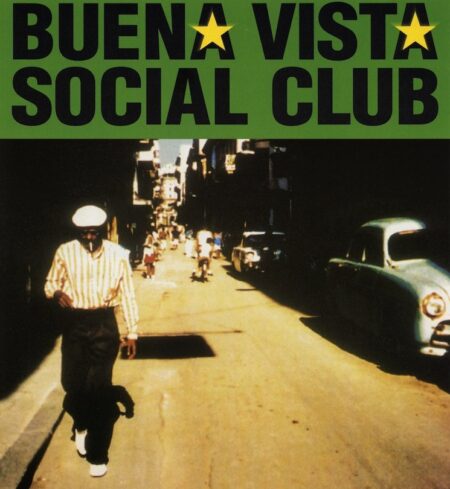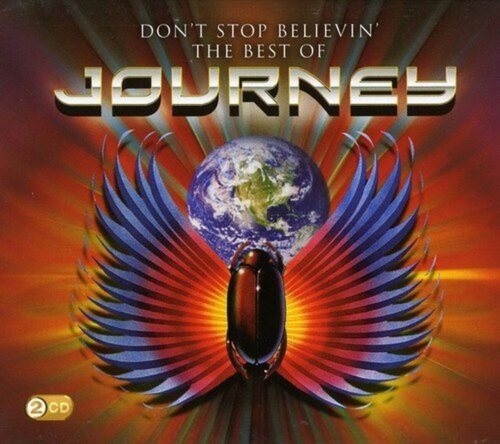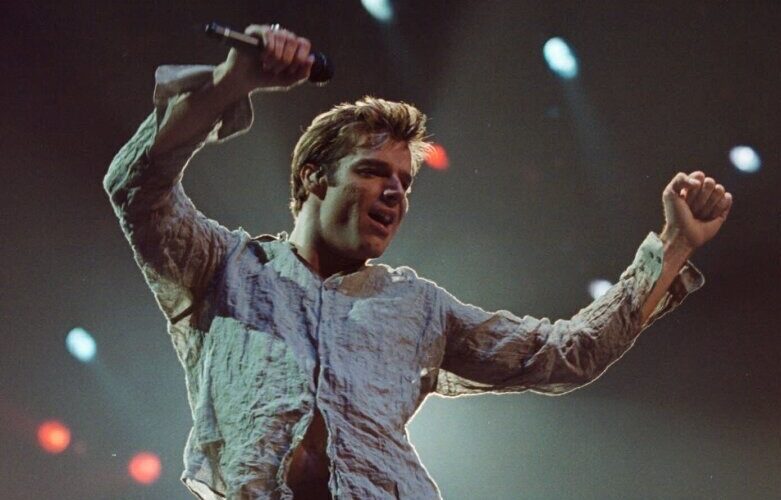Ricky Martin. Photo: YouTube
Recordings by Bonnie Raitt, Linda Ronstadt, Queen, A Tribe Called Quest, Wu-Tang Clan and Broadcaster WNYC on 9/11 Also Among 25 Selected for Preservation
Alicia Keys’ debut album “Songs in A Minor,” Ricky Martin’s “Livin’ La Vida Loca” and Journey’s “Don’t Stop Believin” are some of the unforgettable sounds of the nation’s history and culture joining the National Recording Registry of the Library of Congress. The 2022 class includes important inductions of hip-hop and Latin music, including recordings by Linda Ronstadt, A Tribe Called Quest, Wu-Tang Clan and Buena Vista Social Club.
Librarian of Congress Carla Hayden today named 25 recordings as audio treasures worthy of preservation for all time based on their cultural, historical or aesthetic importance in the nation’s recorded sound heritage.
“The National Recording Registry reflects the diverse music and voices that have shaped our nation’s history and culture through recorded sound,” Hayden said. “The national library is proud to help preserve these recordings, and we welcome the public’s input. We received about 1,000 public nominations this year for recordings to add to the registry.”
The recordings selected for the National Recording Registry bring the number of titles on the registry to 600, representing a small portion of the national library’s vast recorded sound collection of nearly 4 million items.

The latest selections named to the registry span from 1921 to 2010. They range from rock, pop, R&B, hip-hop and country to Latin, Motown, jazz, and recordings of history as it happened. In addition to the musical selections, the new class includes the famous speeches of President Franklin D. Roosevelt, WNYC’s broadcasts on 9/11 and a podcast interview with comedian Robin Williams.
Keys described her album, “Songs in A Minor,” as a story and one of her favorite albums as she recalled writing songs like “Troubles,” “Rock wit U,” “A Woman’s Worth” and “Fallin’” in her teens and recording them in her one-bedroom Harlem apartment.
“I’m so honored and grateful that ‘Songs in A Minor,’ the entire album, gets to be recognized as such a powerful body of work that is just going to be timeless,” Keys said of her album’s induction into the registry.
NPR’s “1A” will host several features in the series, “The Sounds of America,” on this year’s selections for the National Recording Registry, including interviews with Hayden and several featured artists in the weeks ahead. Follow the conversation about the registry on Twitter and Instagram @librarycongress and #NatRecRegistry.
You can listen to many of the recordings on your favorite streaming service. The Digital Media Association, a member of the National Recording Preservation Board, has compiled a list of some streaming services with National Recording Registry playlists on its website.
Defining Sounds of Hip-Hop
Several recordings joining the registry were influential in helping to deepen and grow the genres of rap, hip-hop and R&B in American culture.
A Tribe Called Quest’s 1991 album, “The Low End Theory” was the group’s second studio release and came to be seen as a definitive fusion of jazz and rap with its distinctive sound. «We are honored to have our work added to the prestigious National Recording Registry amongst so many other astounding works,” said rapper Q-Tip. “We are humbled and grateful for this acknowledgement. Thank you so, so much.»
Wu-Tang Clan’s 1993 album “Enter the Wu-Tang (36 Chambers)” would shape the sound of hardcore rap and reasserted the creative capacity of the East Coast rap scene. The group’s individual artists would go on to produce affiliated projects that deepened the group’s influence for decades in hip-hop.
By 2001, the young singer-songwriter Alicia Keys released her debut album, “Songs in A Minor” and achieved new independence with record producer Clive Davis in the process. Keys had written and recorded much of the album under a previous record deal, but the label rejected it. Keys described her influences on the album as a “fusion of my classical training, meshed with what I grew up listening to,” which included the jazz from her mother’s record collection, along with the classic R&B and hip-hop that was prevalent in her New York City neighborhood. Keys’ fusion of influences would produce a sound all her own.

“But what is it about (the album) that I think resonates with everybody for so long?” Keys said. “I just think it was so pure. … People hadn’t quite seen a woman in Timberlands and cornrows and really straight 100% off of the streets of New York performing
classical music and mixing it with soul music and R&B … And people could find themselves in it. And I love that.”
Latin Music Reaches New Audiences
The 2022 class also adds a number of defining Latin sounds to the nation’s audio history from legendary artists.
While Linda Ronstadt is best known for her work in country, rock and pop music, she often referenced her Mexican-American roots. In 1987, she paid full tribute to her heritage with her album “Canciones de Mi Padre,” recorded with four distinguished mariachi bands. The album quickly went double platinum, won a Grammy, and is the biggest-selling non-English recording in American recording history. It would also introduce mariachi music to countless new listeners.
“Canciones de Mi Padre is an album I’ve always wanted to make because of my Mexican heritage,” Ronstadt said. “I love the musical traditions that came with it. I always thought they were world-class songs. And I thought they were songs that the music could transcend the language barrier.”
While she was learning the music and lyrics, Ronstadt said she never worked so hard in her life. By the time she opened a show for the album in San Antonio, it all paid off.
“I looked out to the faces of the audience; it was packed,” Ronstadt said. “There were three generations of families there. They all sang along with the songs. They knew them all. It was really fun.”
When guitarist Ry Cooder and producer Nick Gold assembled an all-star ensemble of 20 Cuban musicians in 1996, the “Buena Vista Social Club” was reborn to record some of the key Cuban musical styles of son, danzon and bolero. The album’s surprising popularity helped fuel a resurgence of Cuban and Latin music, propelled the band to concert dates in Amsterdam and New York’s Carnegie Hall, and led to a popular film by director Wim Wenders.
Soon after, a young Puerto Rican named Ricky Martin would become the “original Latin Crossover King,” paving the way for the globalization of Latin pop with his first major U.S. release, “Livin’ La Vida Loca,” a worldwide smash hit in 1999. Written by Draco Rosa and Desmond Child, the song went No. 1 in 20 countries and was certified platinum in the U.S., the UK and Australia. It remained at No. 1 on the Billboard Hot 100 for five consecutive weeks and would help define Martin’s career. Later, it was named the ASCAP Song of the Year, the BMI Latin Awards Song of the Year and would win four Grammys.
History as it Happens
The recordings added to the registry also include sounds of history as it happened. New to the registry this year are the complete presidential speeches of President Franklin D. Roosevelt from 1933 to 1945, which ranged from events such as the attack on Pearl Harbor to the campaign against polio. His speeches became defining political and social texts of their day.
Public radio station WNYC’s broadcasts from Sept. 11, 2001, also join the recording registry this year. The NPR station from New York City broadcast the chaotic first details of the attack on the World Trade Center from its studios just blocks away, and the station would struggle to keep its signal live because its transmitters were atop one of the towers. Remarkably, the WNYC staff remained on the air throughout the day.
About the National Recording Registry
Under the terms of the National Recording Preservation Act of 2000, the Librarian of Congress, with advice from the National Recording Preservation Board, selects 25 titles each year that are “culturally, historically, or aesthetically significant” and are at least 10 years old. More information on the National Recording Registry can be found at loc.gov/programs/national-recording-preservation-board/about-this-program/. The public may nominate recordings for the Registry here.
Some registry titles have already been preserved by the copyright holders, artists or other archives. In cases where a selected title has not already been preserved, the Library of Congress National Audio-Visual Conservation Center works to ensure that the recording will be preserved by some entity and available for future generations. This can be through the Library’s recorded-sound preservation program or through collaborative ventures with other archives, studios and independent producers.

The national library maintains a state-of-the-art facility where it acquires, preserves and provides access to the world’s largest and most comprehensive collection of films, television programs, radio broadcasts and sound recordings (loc.gov/avconservation/). It is home to more than 9 million collection items.
The Library of Congress is the world’s largest library, offering access to the creative record of the United States — and extensive materials from around the world — both on-site and online. It is the main research arm of the U.S. Congress and the home of the U.S. Copyright Office. Explore collections, reference services and other programs and plan a visit at loc.gov; access the official site for U.S. federal legislative information at congress.gov; and register creative works of authorship at copyright.gov.
National Recording Registry, 2022 Selections
(chronological order)
- “Harlem Strut” — James P. Johnson (1921)
- Franklin D. Roosevelt: Complete Presidential Speeches (1933-1945)
- “Walking the Floor Over You” — Ernest Tubb (1941) (single)
- “On a Note of Triumph” (May 8, 1945)
- “Jesus Gave Me Water” — The Soul Stirrers (1950) (single)
- “Ellington at Newport” — Duke Ellington (1956) (album)
- “We Insist! Max Roach’s Freedom Now Suite” — Max Roach (1960) (album)
- “The Christmas Song” — Nat King Cole (1961) (single)
- “Tonight’s the Night” — The Shirelles (1961) (album)
- “Moon River” — Andy Williams (1962) (single)
- “In C” — Terry Riley (1968) (album)
- “It’s a Small World” — The Disneyland Boys Choir (1964) (single)
- “Reach Out, I’ll Be There” — The Four Tops (1966) (single)
- Hank Aaron’s 715th Career Home Run (April 8, 1974)
- “Bohemian Rhapsody” — Queen (1975) (single)
- “Don’t Stop Believin’” — Journey (1981) (single)
- “Canciones de Mi Padre” — Linda Ronstadt (1987) (album)
- “Nick of Time” — Bonnie Raitt (1989) (album)
- “The Low End Theory” — A Tribe Called Quest (1991) (album)
- “Enter the Wu-Tang (36 Chambers)” — Wu-Tang Clan (1993) (album)
- “Buena Vista Social Club” (1997) (album)
- “Livin’ La Vida Loca” — Ricky Martin (1999) (single)
- “Songs in A Minor” — Alicia Keys (2001) (album)
- WNYC broadcasts for the day of 9/11 (Sept. 11, 2001)
- “WTF with Marc Maron” (Guest: Robin Williams) (April 26, 2010)
National Recording Registry, 2022 Selections (about each selection)
“Harlem Strut” — James P. Johnson (1921) (single)
James P. Johnson (1894-1955), a native of New Brunswick, New Jersey, was one of the creators of the jazz piano style known as “Harlem Stride,” which fused elements of ragtime with an active left hand that provided a bass characterized by wide leaps, or “strides.” “Harlem Strut,” a multi-strain work and a Johnson original, was his first recorded selection, although he did cut piano rolls prior. This recording, along with Eubie Blake’s “Sounds of Africa,” lays claim to being the first recordings of Harlem Stride piano. Today, James P. Johnson is best remembered as the composer of “The Charleston” and as the mentor of pianist and composer Thomas “Fats” Waller.
Franklin D. Roosevelt: Complete Presidential Speeches (1933-1945)
The most famous speeches by Franklin D. Roosevelt are tied to singular events — such as the attack on Pearl Harbor — but many of his most influential addresses were actually made on otherwise mundane occasions in the 1930s such as his tour of a flood control project in 1936, when he delivered the blistering “I Hate War” speech, anticipating World War II. Others reverberate in our time for different reasons, such as when he spoke on behalf of the campaign against polio, now nearly eradicated but a dreaded scourge in that era of which he was the disease’s most famous victim. His
speeches are far more than sources for historical soundbites, they are defining political and social texts of their day that form a narrative of the 12 years of his presidency and of an historical epoch.
“Walking the Floor Over You” — Ernest Tubb (1941) (single)
If “Walking the Floor Over You” wasn’t the first honky-tonk hit in country music, it’s certainly on the short list. Recorded by “Texas Troubadour” Ernest Tubb, on April 26, 1941 at Bunny Biggs’ studio in Dallas, it was notable for the prominence of an electric guitar, played by Fay “Smitty” Smith. Although Bob Wills had used an electric guitar as early as 1935, Wills did so in the context of his large, Western swing group, the Texas Playboys. Reportedly, Tubb wanted to include an electric guitar so his records would sound louder on jukeboxes and be heard above the din of roadhouses and honky tonks, the noisy, sometimes rowdy clubs that gave the genre its name. So, the use of electric or steel guitar in songs like “Walking the Floor,” signified not the first appearance of those instruments in country music, but rather the emergence of a new style. “Walking the Floor Over You” was not only a hit, it was influential far beyond the confines of country music, begetting covers by artists as diverse as Bing Crosby, Georgia Gibbs, Pat Boone and Brook Benton. Tubb himself recorded the song several times, but it’s this 1941 performance, originally released as Decca 5958, that is generally regarded at the classic.
“On a Note of Triumph” (May 8, 1945)
Writer Norman Corwin’s radio tribute to the Bill of Rights, “We Hold These Truths,” was heard by the largest radio audience to date in December of 1941, a people searching for affirmation in the wake of their country’s entry into World War II. Three and a half years later, “On a Note of Triumph,” his salute to the Allied victory in Europe, aired the evening of V-E Day, May 8, 1945. An enormous audience tuned in again, and an encore performance aired five days later and was issued as a record album. The script of the program was rushed into bookstores within a week of the first performance. The 60-minute production was anchored by the passionate narration of Martin Gabel, who led a sonic tour of the years leading up to the war, its battlefields, and the homes of ordinary people. The title aptly describes the program’s thunderous opening and proclamation of victory. The tone changes, however, and voices are heard asking questions like “what do we know now that we didn’t know before?” and “what do we do now?” Although not a subtle work, like its predecessor, “On a Note of Triumph” filled a deep need for its audience.
“Jesus Gave Me Water” — The Soul Stirrers (1950) (single) “Jesus Gave Me Water” comes from the first studio session of a young Chicago gospel singer named Sam Cook, seven years before he added an “e” to his last name and gained worldwide fame in pop and R&B. Cook was 19, with only about 18 months of professional experience on the local gospel scene, and had been chosen to replace the much loved and respected leader of the group, R.H. Harris. Without Harris, the group’s future was uncertain, but the combination of its three veteran members with Cook and another recent addition, tenor Paul Foster, was a winner. Cook’s deceptively gentle, mellifluous voice was a new sound in the music, and drew younger audiences back to
gospel programs in droves. Cook excelled at songs that told a story, and “Jesus Gave Me Water” recounts a key event in the life of Jesus, his encounter with the Samaritan woman at the well and the lesson of living water he reveals to her. “Jesus Gave Me Water” sold strongly for the Specialty label in the spring of 1950, reestablishing the Soul Stirrers as a premier group and launching one of American music’s greatest artists.
“Ellington at Newport” — Duke Ellington (1956) (album)
After enduring a decade of waning record sales, Duke Ellington reignited his career via one single solo recorded in 1956. After their short set at the Newport Jazz Festival, on July 7, 1956, Duke and his orchestra were recalled to the stage. One of the numbers they performed at that time was the 1930s composition “Diminuendo and Crescendo in Blue.” For this piece, at first, just the rhythm section played, then they were joined by the full orchestra. Then, saxophonist Paul Gonsalves jumped in, and at the urging of the crowd and Ellington himself, wailed through 27 choruses. The performance was historic. “Time” magazine would later call it a turning point in Ellington’s career and the Duke himself later said, “I was born in 1956 at the Newport Festival.” For decades, this performance was only available to record buyers in a version sourced from a tape where Gonsalves was off-mic and could only be heard beneath the band and audience. But, years later, a location tape recorded for overseas broadcast by Voice of America was discovered, and a restored version was finally released as part of a 1999 CD set.
“We Insist! Max Roach’s Freedom Now Suite” — Max Roach (1960) (album)
Throughout his career, drummer Max Roach constantly sought to extend the boundaries of jazz, both stylistically and in the service of political change. “We Insist!” consists of an innovative suite featuring singer Abby Lincoln performing lyrics by Oscar Brown, Jr., accompanied by Roach, legendary tenor sax player Coleman Hawkins (on “Driva’ Man”), Booker Little (trumpet), Julian Priester (trombone), Walter Benton (tenor sax) and James Schenk (bass). Shortly after the album’s release, Roach stated that he would “never again play anything that does not have social significance,” and he urged Black musicians to “employ our skill to tell the dramatic story of our people.” The album masterfully fulfills this brief. “Driva’ Man” focuses on the history of slavery and the notorious figure of the slave driver, while “Freedom” and “Tryptich: Prayer/Protest/Peace” deal with emancipation, the ambiguous legacy of freedom, and protest. Side two, devoted to pan-African themes, features a larger percussion ensemble including Babatunde Olatunji, Raymond Mantilla and Thomas Du Vall. The resulting works are heavily influenced by African rhythms; they also foreshadow Roach’s future work with the percussion ensemble M’Boom.
“The Christmas Song” — Nat King Cole (1961) (single)
One of America’s favorite holiday songs was inspired by a hot summer day. During a sweltering July afternoon in 1945, while visiting his frequent songwriting collaborator, Robert Wells, at his Toluca Lake, California, home, Mel Tormé noticed some lines Wells had written to distract himself from the heat, with wintry images like “Jack Frost nipping at your nose.” Sensing their potential as a song, Wells and Tormé went to work and in less than an hour created an enduring holiday standard. Although Tormé himself was an accomplished singer, he felt that a bigger name was needed to generate more
record sales. He and Wells pitched the song to Nat King Cole, the leader of a long established jazz trio, who was becoming a popular vocalist. Cole recorded “The Christmas Song” four times: in June 1946 with just his Trio; in August of that same year with an added string section; in 1953 with a full orchestra, conducted by Nelson Riddle, and in 1961 with a full orchestra, conducted by Ralph Carmichael, the first stereo version and the one most commonly heard today. According to reports, King Cole Trio guitarist Oscar Moore created the “Jingle Bells” coda heard at the end of every one of Cole’s versions. “The Christmas Song” is said to be one of the most recorded holiday songs in history, but it’s Cole’s 1961 performance, with perhaps his most lush vocal take, that is generally regarded as definitive.
“Tonight’s the Night” — The Shirelles (1961) (album)
The Shirelles are often referred to as a “girl group,” but as their first album demonstrates, they sang with the grown-up passion of teens entering their 20s, a winning combination that made them trendsetters in the early 1960s. Shirley Owens, Beverly Lee, Doris Kenner and Adele “Micki” Harris met in junior high school in Passaic, New Jersey. The three hit singles from, this, their first album — “Will You Love Me Tomorrow,” “Dedicated to the One I Love,” and the title track — remain moving performances that still communicate maturing desire with plaintive vulnerability, while other album tracks like “Boys,” later covered by the Beatles, are delivered with untroubled gusto and abandon. “Tonight’s the Night,” may have once seemed like kid’s stuff, but it has stood the test of time.
“Moon River” — Andy Williams (1962) (single)
Though first introduced to audiences in the 1961 Audrey Hepburn film “Breakfast at Tiffany’s” (in which Hepburn herself sang it), “Moon River” is forever associated with smooth pop singer Andy Williams. It became his signature hit, and he sang the first eight bars of the song at the beginning of each and every episode of his long-running television variety show. Simple yet endearing, the song’s evocative lyrics, as the “Financial Times” once noted, “are a metaphor of yearning for the unpredictable eddies of an adventurous life, to be swept along by the currents of somewhere new.” The success of the song made it a modern standard and relaunched the career of its lyricist Johnny Mercer. Though “Moon River” has gone on to be recorded more than 500 times by everyone from Frank Sinatra to Louis Armstrong to Judy Garland (and there’s even a Joan Rivers funny version and Hepburn’s version certainly has its charms), it is Williams’ flawless rendition that endures.
“In C” — Terry Riley (1968) (album)
Terry Riley’s composition, “In C,” forgoes a traditional score and, instead, is comprised of 53 melodic phrases that may be played and repeated at the discretion of each musician and accommodates any number of instruments. It was first performed in 1964 at San Francisco’s Tape Music Center, where Riley worked with other groundbreaking experimental composers such as Steve Reich, Morton Subotnick and Pauline Oliveros. The composition filled both sides of the album, which Riley recorded for Columbia Record’s Music of Our Time series of albums in 1968, with Riley playing saxophone and leading a group of 10 musicians. This series aimed to introduce to the home listening
public new and experimental music forms, and Riley’s work proved to be a popular and influential release across several genres, including classical rock and jazz. The album’s recording featured a group of performers for whom months of preparation lent confidence to the ever shifting improvisatory nature of the composition.
“It’s a Small World” — The Disneyland Boys Choir (1964) (single)
Richard B. and Robert M. Sherman’s song “It’s a Small World” was first heard at the Disneyland Pavilion of the 1964-1965 World’s Fair in New York. There, guides costumed as Disney characters helped visitors into small boats that took them through tunnels adorned with brightly-colored puppets representing children from around the world, who cheerfully sang it to them. Today, the same experience can be had at Disneyland in California, where the ride was moved and reconstructed after the fair closed at the end of its second season in October 1965. Since then, the song has been heard daily ever since, as well as at other Disney theme parks, making it one of the most widely heard and remembered songs of all time. The motto of the 1964-65 World’s Fair was “Peace, Through Understanding,” but, day by day in the middle of the 1960s, there seemed to be less and less of that in the world. Still, the ride and the song became two of the most hopeful things about the fair, and it has endured. During the fair’s first season, the song was only available on a 7-inch disc at the fair itself but was later distributed to stores between the fair’s two seasons and eventually became part of an album of the same name.
“Reach Out, I’ll Be There” — The Four Tops (1966) (single)
According to the Motown Museum, “Reach Out, I’ll Be There” was the Four Tops’ biggest hit and is considered the vocal group’s theme song. Recorded in Studio A at Hitsville USA and both written and produced by the powerhouse team of Holland- Dozier-Holland, the lyrics grew out of their feeling that women “wanted someone to be there for them, through thick or thin.” Lamont Dozier said that he wanted to write “a journey of emotions with sustained tension, like a bolero.” To achieve that, he “alternated the keys, from a minor, Russian feel in the verse to a major, gospel feel in the chorus.” Levi Stubbs’ impassioned vocal was inspired by an unlikely source: Bob Dylan. According to Dozier, they were inspired by Dylan’s shout singing style on “Like a Rolling Stone” and wanted lead vocalist Stubbs to sing like that. To give his vocal added intensity, Holland-Dozier-Holland put Stubbs at the top of his vocal range so he would have to strain a little. The “galloping” sound, heard prominently at the beginning of the song, is a series of triplet beats struck on the plastic head of a tambourine with no jingles, played by Motown producer Norman Whitfield. Levi Stubbs improvised the lyric, “Just look over your shoulder.” It sounded good, so they kept it in.
Hank Aaron’s 715th Career Home Run (April 8, 1974)
On April 8, 1974, when Hank Aaron stepped up to the plate, history was in the making. He was on the verge of smashing Babe Ruth’s home-run record, and the crowd, radio listeners and even the game’s own announcers were anxious, hopeful and on edge. Their anticipation can be heard, and felt, thanks to WSB-Atlanta’s vivid radio coverage, helmed by the legendary Milo Hamilton. When Aaron hit that homer, Hamilton’s on-air exuberance matched that of those in the stands. Almost as well remembered as the
715th home run itself, Hamilton’s announcing of the breaking of “the record that would never be broken” is one of baseball’s — and radio’s — greatest ever calls.
“Bohemian Rhapsody” — Queen (1975) (single)
“Bohemian Rhapsody” breaks nearly every rule in the playbook for rock songs: it starts with a gentle a cappella intro; it has a complex structure without a chorus; and it clocks in at nearly six minutes. Nonetheless, songwriter and vocalist Freddie Mercury, while acknowledging the risk, was convinced that the public would receive it enthusiastically. Guitarist Brian May remembers the band being largely supportive of Mercury’s composition, finding it “intriguing and original, and worthy of work.” In fact, the recording required a huge amount of work with one section requiring 180 overdubs, and the vocal sessions with Mercury, May and drummer Roger Taylor stretched to 10 or 12 hours. Bassist John Deacon does remember an attempt to edit the song, but, in the end, he and the band felt nothing should be lost. Ultimately, “Rhapsody” was released in its full length, and audiences embraced it. The song has proven to have a number of afterlives, appearing in “Wayne’s World” and the bio-pic “Bohemian Rhapsody,” ensuring its continued place in the public’s consciousness.
“Don’t Stop Believin’” — Journey (1981) (single)
Powered by lead singer Steve Perry’s soaring, crystalline lead vocal, “Don’t Stop Believin’” was the second single off the super group Journey’s 1981 album “Escape.” It went to No. 9 on the charts — selling over 7 million copies in the U.S. alone–and has since been described as a “perfect rock song.” While it has never left the airwaves — or Journey’s set list — the song has gained further cultural permanence via its frequent use at sporting games, in the Broadway rock musical “Rock of Ages” (where the song was the show’s big closer) and in film and television, most notably the cryptic final episode of “The Sopranos” and in the debut episode of “Glee.” Additionally, the song, written by Perry with bandmates Neal Schon and Jonathan Cain, has now taken its place, not only as Journey’s greatest legacy, but also as the personal empowerment anthem of millions of people of various generations.

“Canciones de Mi Padre” — Linda Ronstadt (1987) (album)
Even when she was working mainly within the genres of country, rock and pop, Linda Ronstadt often referenced her Mexican-American roots. In 1987, with her remarkable vocal prowess then at its considerable peak, she paid full tribute to this heritage with her album “Canciones de Mi Padre.” Though Ronstadt’s record label was expecting little after the collection’s release, the album quickly went double platinum, earned the Grammy for Best Mexican/Mexican-American album and is the biggest-selling non- English recording in American recording history. The album also spawned two equally successful follow-ups. As its title suggests, “Canciones” is a tribute to the musical history of Ronstadt’s family, incorporating many layers of musical influence. Ronstadt’s album brought 13 classic songs to a previously underserved audience. She recorded her selections with four distinguished mariachi bands (Mariachi Vargas de Tecaltlan, Mariachi Vargas, Mariachi Los Camperos and Mariachi Los Galleros de Pedro Reyand), introducing mariachi music to an untold number of new listeners.
“Nick of Time” — Bonnie Raitt (1989) (album)
Bonnie Raitt released her first album in 1971 and had long been considered a great and respected talent. But, though often critically acclaimed, significant commercial success had often eluded her. In 1989, seven years after being dropped from her previous record label and after suffering a debilitating skiing accident, Raitt rallied herself and returned to the studio. With the assistance of renowned producer Don Was, she not only fashioned the most important album of her career but an album many consider among the best of the decade. “Nick of Time,” Raitt’s 10th LP, would earn three Grammy Awards, including Album of the Year, top the “Billboard” chart, sell 5 million copies and earn a lasting place in the book “1001 Albums You Must Hear Before You Die.” With the aid of Was, Raitt dove deep emotionally and cared little about genre labels or categories. About the record, it was said “[she] never rocks too hard, but there is grit to her singing and playing, even when the surfaces are clean and inviting.” About the album, Raitt herself said, “Basically, it’s a return to my roots.”
“The Low End Theory” — A Tribe Called Quest (1991) (album)
“The Low End Theory” was A Tribe Called Quest’s second studio release and is frequently seen as the definitive record of jazz and rap fusion. Featuring sparse, live-sounding beats and acoustic-feeling bass runs with melodic jazz samples, the production of Ali Shaheed Muhammad showcases the nimble flows of Phife Dawg and Q-Tip, as well as a guest spot from an up-and-coming Busta Rhymes. Lyrically, Tribe infuses the laid-back vibe with deft and infectious chemistry, touching on themes of social awareness and commentary, celebration of Blackness, self-deprecating humor and classic MC boasting as a counterpoint to the rising mainstream popularity of “gangsta rap” that was often seen as glorifying depictions of criminality and violence. The result was a distinctive sound that helped to expand and deepen the sonic palette of the growing rap and hip-hop genres.
“Enter the Wu-Tang (36 Chambers)” — Wu-Tang Clan (1993) (album)
The Wu-Tang Clan released “Enter the Wu-Tang (36 Chambers)” in 1993, in the process shaping the sound of hardcore rap and reasserting the creative capacity of the East Coast rap scene, centered around New York City. The lo-fi sound of the mix, an artifact of the equipment band member RZA employed, communicated the rough-hewn nature of underground rap and the hard experiences that formed the intense, combative, paranoid energy of the group. Across the record, samples from dozens of pulp kung-fu movies lend imagery of a secret knowledge and a warrior’s honor — and blend with the wordplay of the Clan’s MC to develop an evocative mythology. While the Wu-Tang Clan collectively signed with Loud Records to release “Enter the Wu-Tang (36 Chambers),” their contract preserved each artist’s ability to sign with other labels of their choice for solo work. This flexibility enabled a constellation of Wu-Tang affiliated projects to flourish, which served to deepen the influence of the group throughout subsequent decades of hip-hop.
“Buena Vista Social Club” (1997) (album)
In 1996, guitarist Ry Cooder and producer Nick Gold journeyed to Havana, Cuba, to record an all-star ensemble of 20 Cuban musicians, most of whom had been central in
the development of the key Cuban musical styles of son, danzon and bolero. The group adopted the name the Buena Vista Social Club to honor the popular nightclub of the same name at which many of the performers had appeared in the 1940s and 1950s. The album’s surprising popularity helped fuel a resurgence of Cuban and Latin music, propelled the band to concert dates in Amsterdam and New York’s Carnegie Hall, and led to a popular film by director Wim Wenders. Wender’s film, “The Buena Vista Social Club,” was previously selected for the National Film Registry, and it is now fitting to add the record that started all the excitement.
“Livin’ La Vida Loca” — Ricky Martin (1999) (single)
When ex-boy band member Ricky Martin (once part of Latin America’s perpetually young Menudo group) gave a legendary, star-making performance at the 1999 Grammy Awards (singing the World Cup anthem “Cup of Life”), audiences quickly realized that big things were going to be coming from this young singer. But few expected the massive overwhelming popularity of his first major U.S. release, “Livin’ La Vida Loca.” Written by Draco Rosa and Desmond Child, and drenched in the swagger of Martin’s lead vocal, the song went No. 1 in 20 countries and was certified platinum in the U.S., the UK and Australia. Later, it was named the ASCAP Song of the Year, the BMI Latin Awards Song of the Year and would win four Grammys. Earwormy, fun and danceable, yet true to its Latin roots thanks to its horns and percussion, Martin was soon labeled by the press as the “original Latin Crossover King,” in the process paving the way for the globalization of Latin pop and the emergence of such other acts as Shakira, Paulina Rubio and others.
“Songs in A Minor” — Alicia Keys (2001) (album)
On this album, J Records label head, Clive Davis, afforded singer-songwriter Keys great independence in creating the album she wanted to release. Under a previous record deal, Keys had written and recorded much of the album, but the label rejected it. Dissatisfaction with the rejection and the label’s unwillingness to take her seriously led Keys to J Records where Davis’ instinct proved prescient. Keys has described her influences on the album as a “fusion of my classical training, meshed with what I grew up listening to,” which included the jazz from her mother’s record collection, along with the classic R&B and hip-hop that was prevalent in her New York City neighborhood. Reviewers were quick to point out the sophistication and assurance with which the young Keys realized the sound on this album. Her unaffected vocals were capable of expressing feelings from heartbreak to new love and from righteous women’s empowerment to elegant, stylish yearning.
WNYC broadcasts for the day of 9/11 (Sept. 11, 2001)
American media endured one of its greatest tests on the morning of Sept. 11, 2001, and perhaps no New York City media outlet was more directly affected than WNYC-AM and FM. In 2001, the studios for the station were located in the Manhattan Municipal Building, only blocks from the World Trade Center towers and, in fact, the station had its transmitters on top of the towers. An NPR affiliate, the station was in the middle of that day’s “Morning Edition” when, at around 8:50 a.m., the first plane struck the north tower. Down the street, WNYC staffers felt the reverberations in their building and would later see the buildings’ smoke and flames. Breaking in, the station conveyed the first chaotic
details of the day and broadcast the tragedy’s first eyewitness accounts. With WNYC’s broadcast antennas knocked off the air, a quick-thinking engineer switched the AM signal from its microwave connection to a 15khz Telco (telephone company broadcast quality) line to reconnect the AM transmission. Amazingly, this connection was maintained by a pair of small metal clips. As the story unfolded, including the attacks in Washington, D.C., and the crash in Somerset County, Pennsylvania, the dedicated staff of WNYC remained on the air.
“WTF with Marc Maron” (Guest: Robin Williams) (April 26, 2010)
Marc Maron started his “WTF” podcast after losing his radio show at Air America in 2009 at a time when podcasts were largely seen as personal hobby projects or as extensions of established programs. This startlingly intimate conversation with actor and comedian Robin Williams gave the lie to that notion, as have many of Maron’s interviews since. The show is structured around an interview, initially with comedians and actors Maron knew. Each episode opens with a check-in by Maron where he reflects on his life, mental state and reactions to the world around him. These confessional segments work to build a sense of intimacy and investment with the audience and have become a feature in the podcast genre. As the popularity of the program expanded, Maron has interviewed a wide segment of notables including actors such as Harry Dean Stanton and Aubrey Plaza; musicians including Joan Jett, Robbie Robertson and Rosanne Cash; and even President Barack Obama. With nearly 1,300 episodes posted so far, “WTF with Marc Maron’s” popularity has helped to legitimize the podcast as a media format and created an idiosyncratic document of this moment of American culture.




